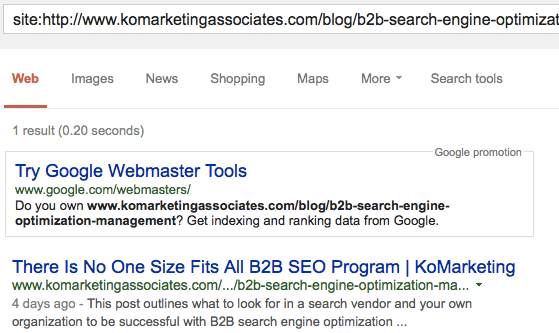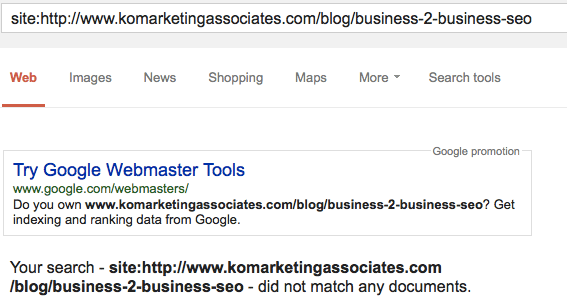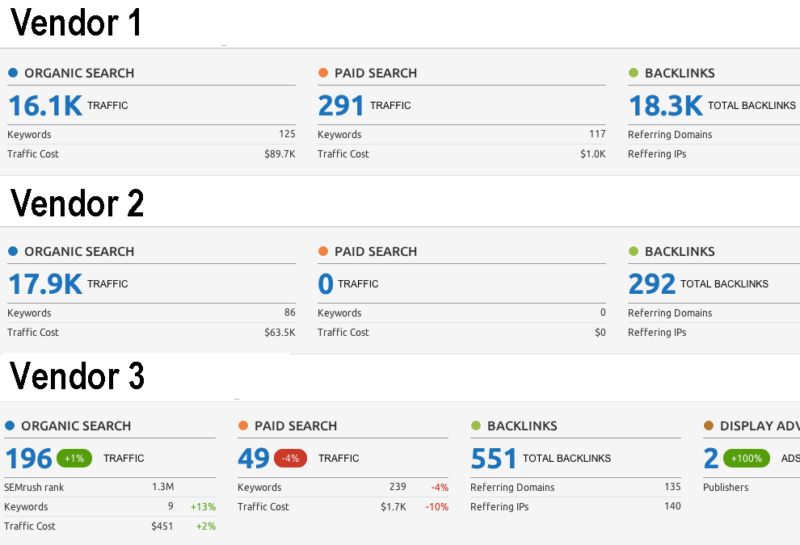The B2B SEO Opportunity In Organizational Mergers & Acquisitions
Mergers and acquisitions present unique opportunities and challenges for B2B search marketers. Columnist Derek Edmond explains how to plan and prepare for the process.
In the summer of 2013, I wrote about the need for B2B SEOs to understand marketing automation technology. My introduction for the column detailed that there were twelve major mergers and acquisitions in just over two-and-a-half years. Organizations spent millions to acquire some of the top vendors in the space.
We worked on an SEO program in the same keyword space during that timeframe. I can attest that all of the major players had robust content marketing programs, high quality inbound links, and were visible for highly competitive search engine results.
A new player in the market might spend tens of thousands of dollars in AdWords for the same keywords. Competitive organizations were producing dozens of content marketing assets on a monthly basis in an effort to acquire traffic, leads and impact SEO.
Imagine losing all of that value if the purchasing organization simply shut down the acquired website!
While it’s true that many acquisitions are much smaller in impact than the scenario above, there still can be SEO value to be realized. For example, we have one client that has completed three acquisitions in the past six months; each acquisition represents a new SEO opportunity.
In this column, I will review the SEO priorities B2B marketers should consider when their organization acquires another business and what they can do to maximize organic search engine presence.
What SEO Has To Do With B2B Mergers & Acquisitions
Quite simply, an acquired organization’s website has some level of search equity — it has most likely acquired inbound links and mentions which have had an impact on their historic search performance and (ultimately) ability to generate leads through organic search.
Take a look at the SEO profiles associated with these three marketing automation vendors (all three have yet to be acquired or have gone public, to the best of my knowledge). I based this summary of high level SEO metrics from data gathered in SEMRush.
All three of these vendors have some organic search engine presence and a short list of inbound links to review. They’ve built their brand large enough that Google recognizes them, and they drive ongoing traffic from organic search.
Key Action Items For B2B SEO
The B2B marketer must redirect all or portions of the acquired organizations’ web properties to their primary site (or applicable destination), which is essentially a site migration. There are several good resources for migrating websites.
Here is a short list for reference:
- Google’s Guidelines for Moving a Website with URL Changes
- SEO Website Redesign Checklist: Don’t Mess Up Your Site Traffic, SEER Interactive
- Navigating a Website Migration like Indiana Jones, TopRank Blog
- From KoMarketing, Have a Merry Website Transition: The Complete SEO Checklist
There are three key components of a site migration that B2B marketers need to consider when they acquire another organization’s website assets:
- Keyword Visibility & Performance. The B2B marketer wants to make sure they understand and maintain important search terms the website or web assets already performs well for and / or are primary targets for the business being acquired.
- Content Marketing Assets & Performance. Evaluate the type of content that has been written and how well has it performed, with respect to existing KPIs and goals of the purchasing organization.
- Inbound Link Profile. Understand and evaluate the types of inbound links the acquired organization has earned over time, and identify if there are any significantly valuable third-party relationships to consider.
Ultimately, acquiring another organization’s web assets might provide a significant opportunity for improving the purchasing organization’s SEO presence, for both short and long-term performance.
Merger Best Practices & Action Items
While I’ve identified resources above detailing how to migrate a website, here are best practices to consider. I break up site acquisition into three phases: pre-launch, at-launch, and post-launch program initiatives. Each one is important to ensure that the transition is as smooth as possible and to prepare for the inevitable hiccups and obstacles that occur.
Pre-Launch Initiatives
Establish timelines and identify tasks and resources in preparation for the transition of site assets to happen. If you haven’t done so already, make sure to have the following addressed:
- A mapping of the acquired websites’ existing URLs to applicable destinations, for establishing 301 redirects at the time of transition. (Click here for an example.)
- Registration with Google and Bing Webmaster Tools (for both the site owned and to be acquired) so that the right reports can be accessed (see next bullet) and information can be updated at time of launch.
- Webmaster Tools-specific inbound link reports and search query reports to identify key third-party resources and important keyword to monitor.
- Access to traditional web reporting tools for ongoing performance review, post-launch.
With this information in hand, you should be ready to move forward with the transition of online assets from the acquired company. Moz has a handy reference for understanding what redirects are and why 301 redirects in particular are important for search engine optimization. The 301 redirect is a key element to every site migration, merger, or acquisition of online assets.
Note: In some circumstances, an organization is only acquiring a business unit or division of another company. The rules still apply for the associated web pages being transitioned.
While it might be difficult to gain access to the selling organization’s Webmaster Tools information or traffic reporting, Screaming Frog can be configured to obtain data from a sub-directory of a primary website, and SEMRush can provide the keyword presence and link information for an individual web address.
At-Launch Initiatives
This might seem obvious, but I’ve definitely come across situations where no one from the marketing team planned on being available when the site transition was scheduled to actually happen. That is probably a mistake (#understatement).
Once the site or site assets are officially 301 redirected (which could take several hours based on domain registrars), I recommend checking the following:
- Test redirected web pages based off of your mapping documentation.
- Test high priority pages and information to ensure proper redirection.
- Perform a site lookup in Google (site:domain.com) to verify pages redirect properly.
- Prepare an updated XML sitemap and submit to Google / Bing Webmaster Tools for re-verification.
It’s inevitable that a few hiccups will occur, but hopefully they are minor and the right preparation and resources are in place to provide quick mitigation.
How long should the old site / site assets remain intact and online?
An article from Google back in 2008 recommended retaining control of your old site domain for at least 180 days. While I’ve been a part of successful projects where this timeline has been much shorter, it’s a good rule of thumb to follow when delivering expectations to key stakeholders.
Post-Launch Initiatives
For larger websites, the process of testing and evaluation can take days or even weeks. After the 301 redirects are in place and verified, an updated sitemap should be submitted to Google and Bing Webmaster Tools, so search engines will quickly crawl the new site.
It is possible to test whether Google has indexed or removed a web address by entering “site:domain.com/web-address” in Google search. Here are examples of what might be seen if a page is indexed (Fig. 1) or is not indexed (Fig. 2), to provide confidence that a redirect is working correctly.

Fig. 1: Search Result Example of an Indexed Web Page

Fig 2: Search Result Example for a Page Not in Google’s Index
The other big post-launch initiative is notifying key third-party publishers that the site / web page destination has changed. This is where the inbound link report from Google Webmaster Tools comes in handy, but link building resources such as Open Site Explorer, Majestic, and SEMRush can be used as well.
It’s unlikely every site owner will respond or change the destination URL of their outbound links. Some of the priority locations I look at first include strategic partners, customers, vendor / business directories, and high value third-party publishers. Fortunately, the 301 redirects tackled in the original page mapping should cover (or at least retain most of the value) for those that ignore or cannot initiate change requests.
When working with marketing communication and PR teams, make sure to coordinate and communicate the new web page URLs and keyword strategy involved.
Website Monitoring & Performance Review
Once the transition has been finalized, be sure to monitor Google Analytics and applicable webmaster tools programs to make sure key metrics have not been adversely affected by the transition.
Potential metrics to review include:
- Individual page performance metrics
- Organic search referrals
- Organic search to target pages (new and already a priority)
- Keyword positions in search results
I wrote a column a while back that outlines potential Google Analytics reports B2B marketers should consider using. While the exact menu navigation examples have changed since this was written, it provides a basic idea of where to find information listed in the bullets above.
Final Thoughts
Mergers and acquisitions provide an important and unique opportunity to improve B2B SEO presence for an organization, but only if the right preparation and planning is done in the process. Acquired websites and web assets provide an easy opportunity to transition keyword visibility, add new and valuable content marketing assets, and gain quality inbound links for SEO.
Has your organization been a part of such an initiative? I would love to read your feedback and perspective via comments below.
Opinions expressed in this article are those of the guest author and not necessarily Search Engine Land. Staff authors are listed here.
Related stories
New on Search Engine Land

